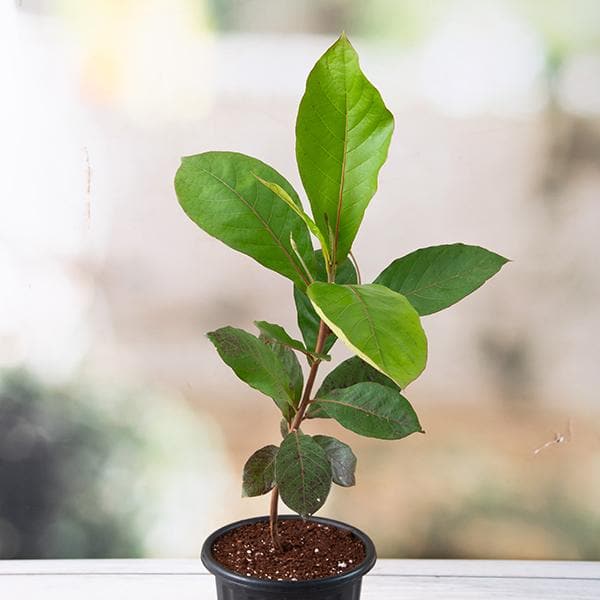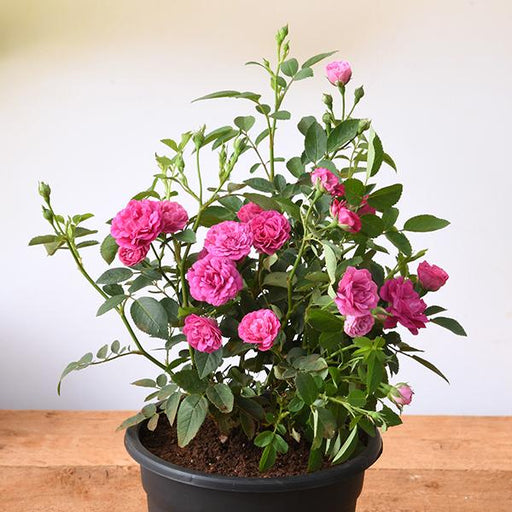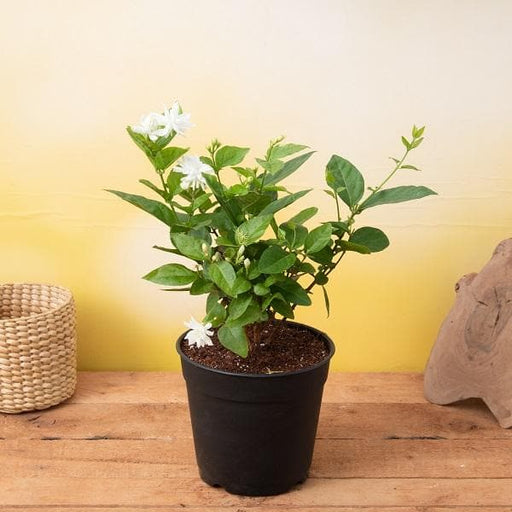
Badam Tree, Indian Almond Tree, Terminalia catappa - Plant
(MRP Inclusive of all taxes)
- Shipping ₹79 for entire order
- Dispatch in 7 days
- Country of origin: India

(MRP Inclusive of all taxes)
 Save 29%
Save 29%
Air Purifier Money Plant with Pot The Air Purifier Money Plant, also known as Pothos or Epipremnum aureum, is a stunning indoor plant that...
View full details
 Save up to 15%
Save up to 15%
Peace Lily, Spathiphyllum - Plant The Peace Lily, scientifically known as Spathiphyllum, is a stunning houseplant celebrated for its elegant white...
View full details
 Save 25%
Save 25%
Jasminum sambac, Mogra, Arabian Jasmine - Plant Jasminum sambac, commonly known as Mogra or Arabian Jasmine, is a fragrant flowering plant...
View full details
 Save 18%
Save 18%
Combo Constituents Includes the Parijat Tree (Night-Flowering Jasmine), a culturally significant plant with fragrant flowers. Description The Pari...
View full details
 Save 25%
Save 25%
Miniature Rose, Button Rose (Any Color) - Plant The Miniature Rose, also known as the Button Rose, is a charming and compact flowering plant that ...
View full details Save 25%
Save 25%
Damascus Rose, Scented Rose (Any Color) - Plant The Damascus Rose, also known as Rosa damascena, is a timeless symbol of beauty and romanc...
View full details
 Save 17%
Save 17%
Beautiful Fragrant Mogra, Arabian Jasmine Plant with Pot The Beautiful Fragrant Mogra, also known as Arabian Jasmine (Jasminum sambac), is...
View full details Save 15%
Save 15%
Pack of Vermicompost and Neem Cake for House Plants Transform your indoor garden with our premium Pack of Vermicompost and Neem Cake, spec...
View full details
Pack of Plant Growth and Flower Boosters Unlock the full potential of your garden with our Pack of Plant Growth and Flower Boosters! This ...
View full details Save 38%
Save 38%
Combo of Jeevamrut and Neem Raksha for Easy Growth and Protection of Houseplants Transform your indoor garden with our exclusive combo of ...
View full details Save 22%
Save 22%
Plant Nutrients Kit (Pack of 16) for a Healthy Garden Transform your garden into a lush paradise with our Plant Nutrients Kit, featuring 1...
View full details Save 16%
Save 16%
Combo of Top Plant Fertilizers Elevate your gardening game with our exclusive Combo of Top Plant Fertilizers, featuring two bags of premiu...
View full details Save 24%
Save 24%
Pack of 4 Additives to Make Soil Healthy and Nutrient Rich Transform your garden into a thriving ecosystem with our Pack of 4 Additives de...
View full details Save 30%
Save 30%
Transform your gardening experience with our premium Combo of Perlite and Vermiculite. This unique blend is designed to enhance soil aeration and ...
View full details Save 27%
Save 27%
Combo of 2 Vermicompost and Cocopeat - Enrich Your Soil Naturally! Transform your garden into a thriving ecosystem with our Combo of 2 Ver...
View full details
 Save 35%
Save 35%
Best 6 Plants for Perfect Indoor Garden Transform your living space into a lush oasis with our curated collection of the Best 6 Plants for a...
View full details
 Save up to 50%
Save up to 50%
Mini Succulent Garden Pack Transform your space with our Mini Succulent Garden Pack, featuring a delightful collection of 4 any variety beautiful s...
View full details
 Save 30%
Save 30%
5 Best Fragrant Plants Transform your garden or indoor space into a fragrant paradise with our curated selection of the 5 Best Fragrant Plants. Th...
View full details
 Save 24%
Save 24%
Set of 2 Bonsai Looking Grafted Adeniums Transform your indoor or outdoor space with our exquisite Set of 2 Bonsai Looking Grafted Adenium...
View full details Save 45%
Save 45%
Top 4 Die Hard Succulents Pack Transform your indoor or outdoor space with our Top 4 Die Hard Succulents Pack, featuring a curated selecti...
View full details
 Save 30%
Save 30%
5 Best Indoor Plants Pack Transform your living space into a lush oasis with our '5 Best Indoor Plants Pack.' This carefully curated collection fe...
View full details
 Save 25%
Save 25%
Set of 4 Evergreen Air Purifier Plant Pack Transform your indoor space into a lush, green oasis with our Set of 4 Evergreen Air Purifier Pla...
View full details| SrNo | Item Name | Qty |
|---|---|---|
| 2 | Badam Tree, Indian Almond Tree Plant | 1 |
The Badam Tree, scientifically known as Terminalia catappa, is a tropical tree native to the Indo-Pacific region. Renowned for its broad, spreading canopy and distinctive, almond-shaped leaves, this tree not only enhances the beauty of any landscape but also provides shade and habitat for various wildlife. Its edible nuts are a source of nutrition and have been used in traditional medicine for centuries.
What makes the Badam Tree special is its adaptability to different soil types and climates, making it a popular choice for both urban and rural settings. Its vibrant foliage transitions from green to a stunning red and yellow in the fall, creating a picturesque scene. Additionally, the tree's ability to sequester carbon makes it an excellent choice for environmentally conscious gardeners.
One of the standout features of the Badam Tree is its resilience against drought and salt, making it ideal for coastal areas. Its large, leathery leaves not only provide shade but also contribute to soil health by returning nutrients as they decompose.
The Badam Tree plays a crucial role in combating climate change by absorbing carbon dioxide. Its extensive root system helps prevent soil erosion, especially in coastal areas, while its shade provides a habitat for various species, promoting biodiversity.
The Badam tree, also known as the Indian Almond tree, is not just a pretty face in the botanical world. Its leaves, bark, and nuts are packed with health benefits that could make even your gym trainer jealous. Rich in antioxidants, the nuts are a crunchy delight that can help lower cholesterol and improve heart health. Plus, the tree itself provides shade that’s perfect for lazy afternoons. Who needs a beach when you have a Badam tree to lounge under?
Caring for your Terminalia catappa is like nurturing a diva; it requires attention but rewards you with beauty. This tree thrives in well-drained soil and loves a good sunbath. Water it regularly, but don’t drown it—this isn’t a swimming competition! Pruning is essential to keep it looking fabulous, and don’t forget to check for pests. A happy Badam tree is a stunning addition to any garden, and it might just become the talk of the neighborhood.
The Indian Almond tree is the Swiss Army knife of the plant world. Its leaves can be used for medicinal purposes, while the nuts are a tasty snack. The wood is durable and can be used for furniture, and the tree itself provides excellent shade. It’s like having a multi-talented friend who can cook, fix your furniture, and still look good doing it. Who knew a tree could be so versatile?
If you’re looking for a fast-growing friend, the Badam tree is your go-to. This tree can grow up to 2 feet a year, making it the Usain Bolt of the plant kingdom. With the right conditions—plenty of sunlight and well-drained soil—you’ll have a towering beauty in no time. Just remember, patience is key; even the fastest trees need a little time to reach their full glory.
Propagating your Terminalia catappa is easier than pie—if pie were made of seeds! You can grow this tree from seeds or cuttings, and it’s as simple as planting them in well-drained soil. Just give them some love, water, and sunlight, and watch them flourish. It’s like raising a child, but with less drama and more shade. Soon, you’ll have a mini forest of Badam trees to show off to your friends.
The Badam tree is the ultimate showstopper in landscaping. With its broad canopy and stunning foliage, it can transform any dull garden into a tropical paradise. Plant it as a focal point or use it to create a natural privacy screen. It’s like the celebrity of the garden world, drawing attention and admiration wherever it goes. Plus, who wouldn’t want to say they have an Indian Almond tree in their backyard?
The fruit of the Indian Almond tree is a delightful treat for both humans and wildlife. These greenish-yellow drupes are not just eye candy; they’re packed with nutrients. While they may not be the most popular fruit in the grocery store, they can be used in jams, jellies, and even as a natural remedy. It’s like the underdog of the fruit world, waiting for its moment to shine.
If you’re in search of the perfect shade tree, look no further than the Badam tree. Its expansive canopy provides a cool refuge from the blazing sun, making it an ideal spot for picnics or afternoon naps. It’s like having your own personal umbrella, but way more stylish. Plus, the dappled sunlight filtering through the leaves creates a magical atmosphere that even fairies would envy.
Every tree has its enemies, and the Terminalia catappa is no exception. While it’s generally pest-resistant, it’s wise to keep an eye out for common culprits like aphids and caterpillars. Think of it as a game of hide-and-seek; you’ll need to be vigilant to catch them before they wreak havoc. A little neem oil or insecticidal soap can send these pests packing, ensuring your Badam tree remains the belle of the ball.
The Badam tree is not picky, but it does have its preferences. It thrives in sandy, well-drained soil, making it the Goldilocks of the plant world—not too wet, not too dry, but just right! If your soil is heavy and clay-like, consider amending it to create a more hospitable environment. After all, a happy tree is a thriving tree, and who wouldn’t want to pamper their leafy friend?
The Indian Almond tree has a rich history that dates back centuries. Native to tropical regions, it has been cherished for its beauty and utility. Ancient cultures used its leaves for medicinal purposes, while sailors valued its wood for shipbuilding. It’s like the tree that has seen it all, from ancient civilizations to modern gardens. Planting one is like inviting a piece of history into your backyard, ready to share its stories.
The Badam Tree, also known as the Indian Almond Tree, is a tropical beauty that flaunts its glossy leaves and delicious almonds. Scientifically known as Terminalia catappa, this tree is a favorite for shade and snacking. Who knew a tree could be both a picnic spot and a snack bar
The Badam Tree can reach impressive heights of up to 100 feet! That’s taller than your average building and perfect for those who want to feel small in nature. Just imagine the view from the top—if you can climb that high without losing your lunch!
The Indian Almond Tree is a multitasker! It provides shade, produces edible almonds, and its leaves are great for fish tanks. Plus, it’s a natural air purifier. Who knew a tree could be the ultimate eco-friendly companion, doing more for the planet than most humans
Caring for a Badam Tree is as easy as pie—almond pie, that is! Just plant it in well-drained soil, give it plenty of sunlight, and water it moderately. Avoid overwatering, or you might end up with a soggy situation. Remember, this tree prefers to be a little thirsty!
The Badam Tree typically starts bearing fruit in about 5 to 6 years. Patience is key! Once it starts, you’ll be rewarded with clusters of delicious almonds. Just think of it as a long-term investment in your snacking future—worth the wait, right
The Indian Almond Tree can be a bit of a show-off in some regions, but it’s not classified as invasive everywhere. It can spread quickly, so keep an eye on it. Think of it as that friend who always wants to be the center of attention—charming but a little overwhelming!
Absolutely! The almonds from the Badam Tree are edible and quite tasty. Just make sure to roast them first; raw almonds can be a bit bitter. So, fire up that oven and get ready for a crunchy snack that’s straight from your backyard!
The Badam Tree thrives in tropical and subtropical climates. It loves warm weather and can’t stand frost—think of it as the diva of the plant world. If you live in a cooler area, you might want to keep this beauty indoors or in a greenhouse!
The Badam Tree is a speedy grower, adding about 2 to 3 feet per year under ideal conditions. It’s like the Usain Bolt of trees! Just give it the right environment, and it’ll shoot up faster than you can say “almond delight.”
The Indian Almond Tree can attract pests like aphids and caterpillars. But don’t worry; a little neem oil or insecticidal soap can send them packing. Think of it as a tiny army defending your tree—just make sure they don’t get too comfortable!
Yes, the Badam Tree can survive in pots, but it prefers to stretch its roots in the ground. If you’re potting it, choose a large container and be prepared for some serious repotting as it grows. It’s like trying to fit a giraffe in a sedan—challenging but doable!
The Badam Tree can live for over 60 years, making it a long-term companion. It’s like that friend who sticks around through thick and thin. With proper care, you’ll have a majestic tree that can outlast many of your relationships!